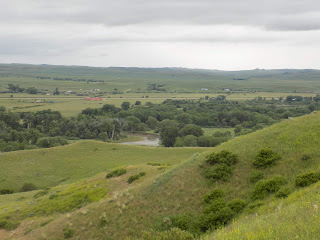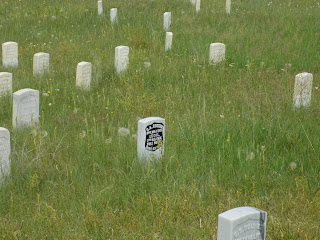This is re-posted from 2018, with revisions.
On June 25-26, 1876, one of the most interesting battles on American soil took place: Little Bighorn. The actual character of the battle, which was spurred by the discovery of gold in the Black Hills, is a bit complicated. It took place as part of a war between the Union and a loose confederation of Sioux, Cheyenne, and Arapaho, the Black Hills War; the campaign itself was partly due to rising tensions created by the Sioux and Cheyenne pushing into Crow territory. Crow were traditional enemies of the Sioux and Cheyenne, and the Crow, whose power had been dwindling for some time, allied with the United States in order not to lose Crow Country. Six of the soldiers in Custer's army were Crow scouts, and the area near where the Little Bighorn River runs is right in the middle of the Crow Reservation.
Custer's loss at Little Bighorn has been attributed to many different factors, but one idea, once common, we can reasonably eliminate: that it was because of some great folly or incompetence on Custer's part. George Armstrong Custer was a competent general, if somewhat self-aggrandizing, and an extraordinarily good cavalry commander; he understood the type of warfare in which he was involved, and he knew how to work with his Crow allies. The Sioux and Cheyenne defeated an experienced cavalry under a man who was one of the Union's very best cavalry commanders. As a clash between two rising empires, it could have gone either way. That it went so lopsidedly against Custer is, I think, due to the fact that he was outmatched, not because he was stupid, but because on his own he could not be a match for the best minds and warriors of the Sioux-Cheyenne alliance at its peak. One notes that the common theme of those trying to argue for Custer's folly is that he should have easily been able to beat primitive Indians. But we have only to look at men like Sitting Bull and Crazy Horse to recognize that these are the kind of men of whom great empires are made.
On June 5, 1876, there was a big Sun Dance held at Rosebud Creek. There Sitting Bull, widely regarded as a very holy man, is said to have had a vision of Union soldiers falling from the sky and a voice saying, "I give you these because they have no ears." This, as well as a good measure of diplomatic skill, allowed Sitting Bull, from a branch of the Sioux that was fairly insignificant at the time (the Hunkpapa) to pull together a tighter alliance of Sioux, Cheyenne, and Arapaho than had been possible before. When Custer's scouts spotted the Sioux encampment from fourteen miles away, he was dealing with an Indian army that was far more cohesive and focused than he or anyone else had ever known, and one that was far larger than anyone could have expected. Some of Custer's scouts warned him that something strange was going on -- but they did not fully understand what was going on, themselves, and it is difficult to convey a new thing. Custer's primary concern was to prevent the large group from scattering; his plan was to swoop in quickly, take a large number of hostages, and use it to force concessions from the enemy with minimal bloodshed and minimal need for further battles. In most cases it would have been a very good plan, and similar plans had been highly effective before. But Sitting Bull had started something new. He did it not by issuing commands -- Sioux chieftains generally worked by being chief mediators and negotiators rather than by trying to impose their will -- but by giving a new clarity of goal.
I was at Little Bighorn National Battlefield last Monday, so I have a few pictures. The Little Bighorn River, in Crow Country:
We know that the soldiers had difficult digging trenches because of how dry the soil was, so it would not have been this green in 1876.
The first engagements of the 7th Cavalry were between A, G, M Companies under Major Reno and the Sioux; the idea was to do a lightning strike and then rejoin the rest of the companies under General Custer. Almost as soon as the battle began, however, it was clear that this would not work: the Sioux were not giving way, and Reno was not facing a small detachment but a major force. The Sioux were being organized by Chief Gall, a Hunkpapa associate of Sitting Bull, and an accomplished tactician. Gall had recognized almost immediately that Custer had to be engaging in a two-prong attack, and at every step of the way would anticipate how best to organize Sioux and Cheyenne fire.
Reno managed to get his troops to what is now known as Reno Hill, where they met up with Captain Benteen and Companies D, H, and K.
Benteen's men in the early morning of June 26 tried hastily to dig trenches to give cover to riflemen. With limited tools, they had to use whatever they had at hand, including mess plates and knives.
Indian marksmen fired at them from the ridges to their east:
As the time went on, the situation looked increasingly worse for Reno and Benteen. They were out of water in dry country, all the more frustrating because the river was right there, just out of reach because of Indian fire. In a desperate gamble, Benteen got volunteers on a probably-suicide mission to go to the river and bring back as much water as possible while others attempted to draw enemy fire; by a bare scrape of luck, they succeeded. Four of the riflemen and fifteen of the water carriers would later receive the Medal of Honor.
Captain Weir and Company D eventually managed to extricate themselves enough to rejoin Custer -- but too late. The details of what happened at Custer's Last Stand are obscure and confused, and have to be pieced together from conflicting reports, but repeated waves of Sioux and Cheyenne broke Companies L, I, and C, and some think that Crazy Horse led a flanking attack that resulted in Custer being irreparably surrounded. What is certain is that with Gall having locked down Reno and Benteen for so long, the Sioux and Cheyenne were able to go after Custer with full fury. Custer and others with him died on what has come to be known as Last Stand Hill:
A marker indicates more or less where he fell:
People were hastily buried days later; sometimes they were only identified much later. Custer was eventually reinterred at West Point, but the large number of dead led the War Department to turn the battlefield into Custer National Cemetery, which continued to operate until 1978. Authority over the battlefield was transferred from the War Department to the Department of the Interior in the 1930s.
Increasing interest in the Sioux-Cheyenne side of the tale has led to more care being taken in marking and recording aspects of their fight. There is now a nicely done Indian memorial as well:
It's easier to track the places where Union soldiers fell than Sioux and Cheyenne soldiers, in part because the latter had the chance to remove their bodies rather than having to bury them hastily, but a few have been able to be identified, such as Closed Hand:
One of the few survivors of the Last Stand from the Union side was Curly (or Curley), a Crow Indian Scout, who reported the defeat of the 7th Cavalry. He went on to have a long life, and when he died in 1923 of pneumonia, he was buried at Custer National Cemetery:
The Sioux and Cheyenne had had an extraordinary victory, but in a sense their own success defeated them. Having won so resoundingly, they had no definite next move; warriors began drifting back home and the alliance lost its cohesion. Meanwhile, the shock of the defeat led the United States to send thousands of more soldiers.
The mighty Crazy Horse surrendered in 1877 at Red Cloud Reservation. He was treated well for a while, since he was something of a legend even among Union soldiers, but rumors constantly sprang up about his setting out to war again, and he was eventually arrested. In transport, he was stabbed in the back with a bayonet, supposedly for attempting to escape; there have always been questions about his death. Sitting Bull and his men soon had to flee to Canada, where lack of bison made it difficult to feed themselves. He eventually had a falling-out with Gall, who surrendered to the United States and was transported to the Standing Rock Reservation. Sitting Bull himself surrendered in 1881, and also transferred to Standing Rock, but as he was seen as a special threat, he and his band were kept separately from the other Hunkpapa for quite some time. To make ends meet, he got involved in Wild Westing, traveling around in Wild West shows, making a rather considerable amount of money, although he gave most of it away to those in need. He and Gall became involved in the Ghost Dance Movement and were shot in bungled confrontations. So passed giants among men.












